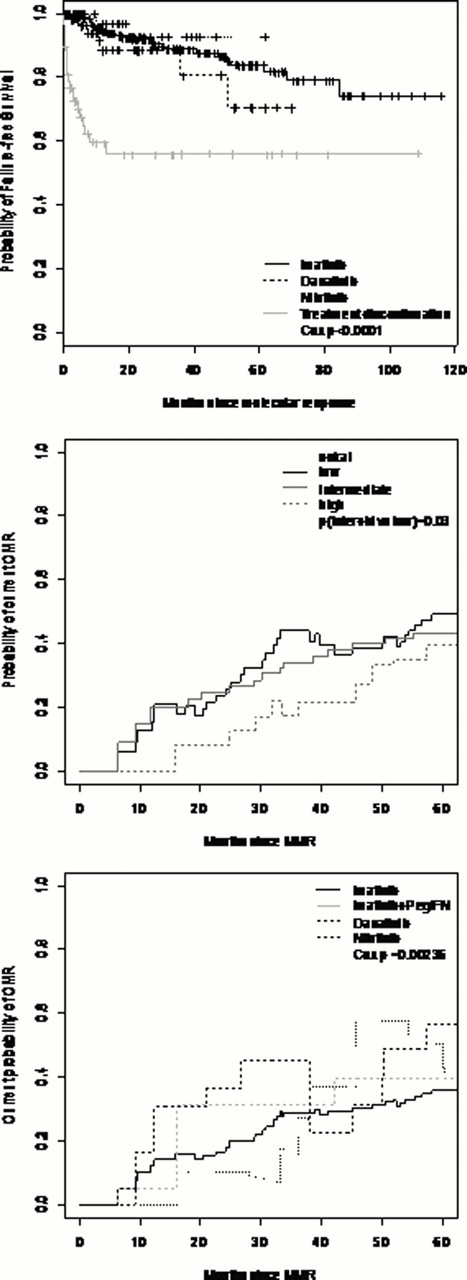Abstract
Abstract 4437
In order to describe the different treatments and factors involved in the first major molecular response (MMR) occurence in chronic phase CML, its maintenance, and its conversion to complete molecular response (CMR), we analyzed 211 CML patients [124 males and 87 females; median age: 50 years (17–81)] in first chronic phase who received tyrosine-kinase inhibitors (TKI) followed at our institution between 2001 and 2011. Among 196 patients evaluated for Sokal score, 79 (40%) were low, 82 (42%) were intermediate and 35 (18%) were high. According to hasford score (153 evaluated), 46% were low, 46% intermediate and 8% were high. First MMR was obtained in: 61% of patients after first line treatment [Imatinib, n=102; Imatinib+Peg-interferon, n=11; Dasatinib, n=10; Nilotinib, n=6]; 26% after second line [Imatinib, n=32; Dasatinib, n=11; Nilotinib, n=12] and 13% beyond second line [Imatinib, n=14; Dasatinib, n=7; Nilotinib, n=6]. The median time of MMR obtention was 15 months (2.5–94) after Imatinib, 6.4 months (3–24) after Imatinib+Peg-interferon, and it was significantly shorter after both Dasatinib [HR=2.6 (1.7–3.9), p<0.001] and Nilotinib [HR=3 (1.8–5), p<0.001] with 6 months (3–23) and 5 months (3–56) respectively no matter the treatment line number was. Sokal score was an independent significant factor that impacted MMR obtention delay, with a median time of 9 months (2.5–98) for low score, 13 months (3–78) for intermediate [HR=0.7 (0.5–0.9), p=0.03] and 12 months (3–94) for high score [HR=0.7 (0.5–1.02), p=0.05]. Patients who converted to CMR were: 50 (34%) under Imatinib after a median time of 25 months (3–97); 7 (64%) under Imatinib+Peg-interferon after a median time of 8 months (3–15); 10 (42%) under Nilotinib after 25 months (13–32) and the only significant faster treatment was Dasatinib [n=13 (46%)] after a median time of 11 months (3–52) [HR=2.1 (1.1–4.2), p=0.02]; according to Sokal score, low (n=41, 52%) and intermediate (n=27, 33%), while patients with high score (n=11, 31%) were significantly slower [HR=0.53 (0.25–1), p<0.001]. The current rate of CMR at 5 years was not statistically different between the treatments [Imatinib (36%), Imatinib+Peg-interferon (40%), Nilotinib (43%), Dasatinib (56.5%)] nor according to sokal score [Low (49%), intermediate (43%) and high (40%)]. Treatment was discontinued in 42 patients who had 5 years failure-free survival of 56% (43–73) while patients under Dasatinib, Imatinib+Peg-interferon, Imatinib, and Nilotinib had 70.5% (50–99), 79% (56–100), 84% (77–91) and 93% (84–100) respectively. In Conclusion, second generation TKI used at 1st, 2nd line or beyond, showed an independent significant faster time to MMR, as well as patients with low sokal score. Conversion to CMR was significantly faster only in Dasatinib patients and slower in patients with intermediate and high sokalscore. Treatment discontinuation did not have a benefit in terms of FFS while patients on TKI therapy seem to have better result.
Nicolini:Novartis, Bristol Myers-Squibb, Pfizer, ARIAD, and Teva: Consultancy, Honoraria, Membership on an entity's Board of Directors or advisory committees, Research Funding.
Author notes
Asterisk with author names denotes non-ASH members.


